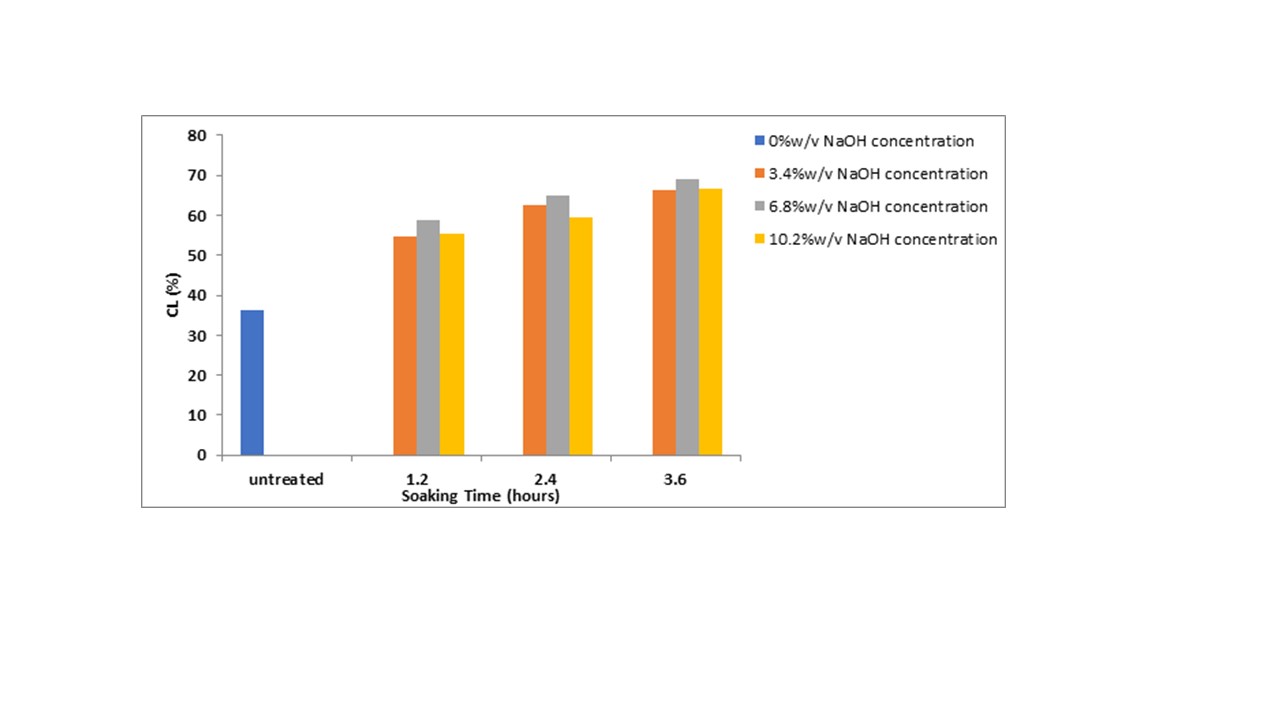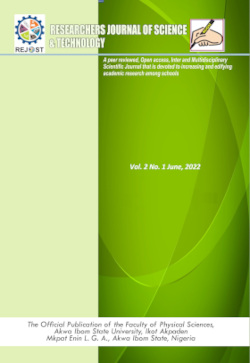Effect of Process Variables on the Composition of Chemically Modified Nauclea latifolia Wood Bark Fiber for Paper Production
Keywords:
Hemicellulose, Lignin, Cellulose, Nauclea Latifolia Wood Bark Fiber, Alkaline pretreatment, FTIR analysis, Paper productionAbstract
The shortage of sustainable fiber sources in the chemical industry highlights the need for alternatives to synthetic fibers, which have been widely used for years. This study examined the effect of NaOH treatment on the chemical composition of a novel fiber obtained from Nauclea latifolia bark wood (NLWBF). The objective was to investigate the influence of NaOH concentration and soaking time on NLWBF. Soaking time and NaOH concentration were varied from 1.2 to 3.6 hours and 3.4 to 10.2 % w/v, respectively. After collection, the NLWBF was processed into powdered form and treated to remove impurities. Both modified and unmodified NLWBF samples at optimum treatment conditions were structurally analyzed using Fourier Transform Infrared Spectroscopy (FTIR) to identify the organic functional groups present. The initial cellulose (CL), hemicellulose (HM), and lignin (LN) contents of NLWBF were 36.83%, 29.71%, and 31.29%, respectively. After chemical modification, the maximum cellulose content of 69.06% was obtained at 3.6 hours and 6.8% w/v NaOH. The optimum hemicellulose content was 18.14%, recorded at 2.4 hours and 6.8% w/v. FTIR spectra revealed the presence of OH, –COOH, C=O, C–O, and C–O–C groups, with noticeable shifts after NaOH treatment, confirming chemical modification. These changes indicated a reduction in hemicellulose and lignin, thereby enhancing the cellulose content of NLWBF. The results demonstrate that NaOH-treated NLWBF, with its improved cellulose composition, holds strong potential as a sustainable raw material for industrial paper.
References
Agu, C. V., Njoku, O. U., Chilaka, F. C., Agbiogwu, D., IIoabuchi, K. V., & Ukazu, B. (2014). Physiochemical properties of lignocellulosic biofibers from south eastern Nigeria; their suitability for biocomposite technology. African Journal of Biotechnology, 13 (20); 2050-2057.
Ahmadi, F, Zamiri, M.J, Khorvash, M., Ziaee, E. & Polikarpov, I. (2016). Pre-treatment of sugarcane bagasse with a combination of sodium hydroxide and lime for improving the ruminal degradability; Optimization of process parameters using response surface methodology. Journal of Applied Animal Research, 44(1), 287–96.
Barlianti, V., Dahnum, D., Hendarsyah, H. & Abimanyu, H. (2015). Effect of alkaline pretreatment on properties of lignocellulosic oil palm waste. Procedia Chemistry, 16; 195–201.
Brinchi, L., Cotana, F., Fortunati, E., & Kenny, J. M. (2013). Production of nanocrystalline cellulose from lignocellulosic biomass; technology and applications. Carbo-hydrate Polymers, 94 (1); 154-169.
Chen, Y., Tshabalala, M. A., Gao J, Stark, N. M., Fan, Y., & Ibach, R. E. (2014). Thermal behavior of extracted and delignified pine wood flour. Thermochimica Acta [Internet]. 591 (January 2018); 40–4. Available from; http;//dx.doi.org/10.1016-/j.tca.2014.06.012.
Dungani, R., Karina, M., Subyakto, Sulaeman, A., Hermawan, D. & Hadiyane, A. (2016). Agricultural waste fibers towards sustainability and advanced utilization; A review. Asian Journal of Plant Sciences. 15(1–2), 42–55. http;//dx.doi.org/10.3923-/ajps.2016.42.55.
Government, R.M, Thaddaeus, J, Thompson, E O., Ani, A. K, Apake, D. D. (2019). Optimizing the cellulose content of shea butter bark wood through alkali pretreatment for composite Application. Indian Journal of Science and Technology, 13(4); 384-394. DOI; 10.17485/ijst/2020/ v 013i04/147288.
Government, R. M., Okeke, E.T., Odera, R. S., Ani A.K., Thaddeus J. & Ikechukwu N. B. (2020a). Significance of alkaline treatment in the composition of mango seed shell fiber for polymer composite application. Indian Journal of Science and Technology. 13(21);2168-2174. https;//doi.org/10.17-485/IJST/v13121.81.
Government, R. M., Thaddeus, J., Thompson E.O., Ani, A.K. and Apake D. D. (2020b). Optimizing the cellulose content of shea butter bark wood fibre through alkali pretreatment for composite application. Indian Journal of Science & Technology. 13(04); 384-399. DOI; 10.17485/ijst/2020-/v013104/147288.
Government, R., Olowokere, J., Odineze, C., Anidobu, C., Yerima, E. & Nnaemeka, B. (2019). Influence of soaking time and sodium hydroxide concentration on the chemical composition of treated mango seed shell flour for composite application. Journal of Applied Sciences and Environmental Management, 23(1), 21 - 28.
Government, R. M., Onukwuli, O. D., & Ani, A. K. 2017; Chemically treated avocado wood flour- LLDPE composite, Usa. Universal Journal of Material Science, 27- 40.
Government, R. M., Onukwuli, O. D., & Jibatswen, T. Y. (2018). Optimization of chemical treatment of avocado pear wood filler on the properties of LDPE composites, International Conference Processing; Fac. Engineering, UNIZIK. 499-509.13th-14th August.
Ikramullah, R., S., Thalib, S. & Huzni, S. (2018). Hemicellulose and lignin removal on typha fiber by alkali treatment. IOP Conference Series; Materials Science and Engineering. 352(1); 1-6.
Indu, M., (2017). History of mango – ‘king of fruits’ International Journal of Engineering Science Invention ISSN (Online); 2319–6734, ISSN (Print); 2319–6726 www.ijesi.org 6 (7); 20-24.
Komuraiah, A, Kumar N. S. & Prasad, B. D. (2014). Chemical composition of natural fibers and its influence on their mechanical properties. Mechanical Composites Materials, 50; 359–376.
Lazic, B. D, Janjic, S. D., Rijavec, T. & Kostic, M. M. (2017). Effect of chemical treatments on the chemical composition and properties of flax fibers. Journal of the Serbian Chemical Society, 82(1);83–97.
Mahyati, P., A. R, Djide, M. N., Taba, D. P., Rauf P., A, & Nasir D. M. (2013). Biodegradation of lignin from corn cob by using a mixture of phanerochaete chrysophobia, lentinus edodes and pleurotus ostreatus. International Journal of Scientific & Technology, 2(11), 1-4.
Marwan, M. & Nasim, U. (2016). Experimental analysis of compressed earth block (CEB) with banana fibers resisting flexural and compression forces. Case Studies in Construction Materials. 5; 53-63.
Muryanto, T. E., Abimayu, H., Cahyono, A., Cahyono, E. T. & Sudiyani, Y. (2015). Alkaline delignification of oil palm empty fruit bunch using black liquor from pretreatment. Procedia chemistry, 16, 99 –105. https://linkinghub.elsevier.com/re-trieve/pii/S1876619615001801.
Naidu, A. Lakshumu, B. Sudarshan, & K. Hari Krishna. (2013). Study on Mechanical Behavior of Groundnut Shell Fiber Reinforced Polymer Metal Matrix Composites." International Journal of Engineering Research and Technology.
Naidu, A. Lakshumu, V. Jagadeesh, & Rajubahubalendruni, M. V. A. (2017). "A review on chemical and physical properties of natural fiber reinforced composites." Journal of Advanced Research in Engineering and Technology, 8(1); 56-68.
Netral, B., Sabu, T., Chapal, K. D. & Rameshwar, A. (2012). Analysis of morphology and mechanical behaviours of bamboo flour reinforced polypropylene composites. Nepal Journal of Science Technology, 13(1); 95-100.
Obasi, H. C. (2015). Peanut Husk Filled Polyethylene Composites; Effects of Filler Content and Compatibilizer on Properties. Journal of Polymers, 1–9.
Okeke, E.T; Government, R. M.; Apake, D. D. & Ani, A. K. (2023). Effects of sodium hydroxide on the compositions of shea butter bark wood fiber for polymeric composite production in structural application. Journal of Applied Science, Environment and Management, 27(7); 1423-
Oushabi, A., Sair, S., Oudrhiri Hassani, F., Abboud, Y., Tanane, O., & El Bouari, A. (2017). The effect of alkali treatment on mechanical, morphological and thermal properties of date palm fibers (DPFs); Study of the interface of DPF–Polyurethane composite. South African Journal of Chemical Engineering, 23;116–23. http;//dx.doi.org/10.1016/j.sajce.2017.-04.005.
Palamae, S., Dechatiwongse, P., Choorit, W., Chisti, Y., & Prasertsan, P. (2017). Cellulose and hemicellulose recovery from oil palm empty fruit bunch (EFB) fibers and production of sugars from the fibers. Vol. 155, Carbohydrate Polymers. Elsevier Ltd.; 491-497.
http;//dx.doi.org/10.1016/-j.carbpol.2016.09.004.
Reddy, K. O., Reddy, K. R. N., Zhang, J., Zhang, J., & Varada Rajulu, A. (2013). Effect of alkali treatment on the properties of century fiber. Journal of Natural Fibers. 10(3), 282–96.
Sari, N. H., Wardana, I. N. G., Irawan, Y. S., Siswanto, E. (2017). The effect of sodium hydroxide on chemical and mechanical properties of corn husk fiber. Oriental Journal of Chemistry, 33(6), 3037–42.
Setswalo, K., Namoshe M., Kutua, S., Oladijo O. P. & Samson, B. (2017). Effect of thermal and alkali treatment on pterocarpus angolensis (mukwa) wood flour. Procedia Manufacturing, 7;205–10.
Shuhaida, H. & Soh, K. G. (2016). Effect of sodium hydroxide pretreatment on rice straw composition. Industrial Journal of Science Technology, 9(21), 1-9.
Suryanto, H., Marsyahyo, E., Irawan, Y. S. & Soenoko, R. (2013). Effect of alkali treatment on crystalline structure of cellulose fiber from mendong (Fimbristylis globulosa) straw. Key Engineering Materials, 2013, 594–595.
Wang, Z., Li, J., Barford, J. P., Hellgradt, K. & Mckay, G. (2016). A comparison of chemical treatment methods for the preparation of rice husk cellulosic fibers. International Journal of Environmental & Agriculture Research, 2(1); 2454–1850. hhttp;//www.ijoear.com/Paper-January-2016/IJOEAR-JAN-2016-11.pdf.
William, J. & Patrick, C. (2017). Improving the properties of banana fiber reinforced polymeric composites by treating the fibers, 3rd international conference on natural fibers; Advanced Materials for a Greener World, ICNF 2017, 21-23 June 2017, Braga, Portugal.

Downloads
Published
How to Cite
Issue
Section
License
Copyright (c) 2025 Researchers Journal of Science and Technology

This work is licensed under a Creative Commons Attribution-NonCommercial-NoDerivatives 4.0 International License.




